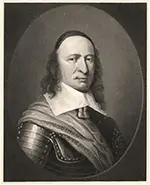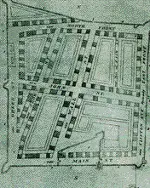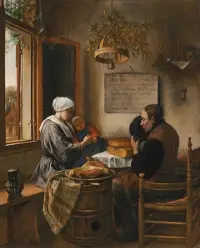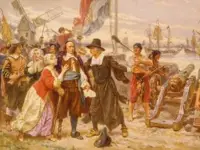The New Netherland colony was a 17th-Century Dutch settlement in North America. The colony lasted for less than a century. It was two years after the English settlement of Jamestown that Dutch settlers established themselves in the New World. The Dutch East India Company hired Henry Hudson, an English sailor, to find a northeast passage to India by ship. He didn't find, but he did explore much of what became the Dutch colony of New Netherland. 
It was the Dutch West India Company that sent a group of 30 families in 1624 to set up the colony, which was at first called New Amsterdam. The first director of the colony was Jan Cornelisse May. They put down roots initially on Governors Island, which they named Noten Eylant, and then dispersed, with several traveling up the Hudson River to what is now Albany. Willem Verhulst took over as director the following year, and Peter Minuit (right) arrived two years later and helped expand the colony by buying Manhattan Island. The colonists had ranged up the Hudson River and built Fort Orange, near the settlement of Beverwijck, what is now Albany. As the Dutch settlers began to fill in the land between their headquarters and the fort–living in what is now Connecticut, Delaware, New Jersey, New York, and Pennsylvania– they increasingly came into contact–and, sometimes–conflict with English settlers. 
Minuit served as director of the colony for a time but was replaced by Wouter van Twiller, who sent an expedition up to the Connecticut River in the 1630s. The Dutch would-be settlers found that the English settlers living there weren't much for sharing and were willing to take up arms to prove it, so the Dutch abandoned that idea. It would not be the last time the two countries argued over territory. Dutch settlers in the upper Hudson River valley were engaged in the fur trade and maintained friendly relations with the Native Americans tribes living in the area. In the lower Hudson River valley, however, the Dutch carried out a series of violent actions against local Native Americans. In 1640, the Dutch West India Company abandoned its monopoly and allowed others to invest in the colony, which soon reached the pinnacle of its economic success. The prosperity was short-lived, as a series of ineffective directors proved unable to stop a growing smuggle trade and lawlessness. 
Peter Stuyvesant took over as head of the colony in 1647 and set about trying to repair the damage done in the preceding years. Ruling with a strong hand (He famously said, "I shall govern you as a father his children."), Stuyvesant set the colony back on a productive course. New Netherland was also known for being welcoming to refugees to other countries. At one time or another, the colony was home to Croats, English, french, German, Italians, Irish, and Italians. As well, the colony was known for its religious tolerance. Jews were not turned away, as was the case with certain English colonies; and Catholics and Protestants managed to live in the same colony, if not side-by-side. Significantly, a small number of Africans lived in the colony. Some were slaves of Dutch settlers; others were free. Dutch colonists lived in wood and, later, brick and stone houses that were designed slightly differently than English houses. One distinct feature of a Dutch house was a door that was split horizontally, so that people could open the top to let in fresh air while essentially keeping the door shut. Dutch settlers slept in bed boxes that could be closed from the inside. In 1655, New Netherland absorbed the New Sweden colony. New Sweden director John Rising and a group of men had taken over the Dutch Fort Casimir and renamed it Fort Trinity in 1654. Stuyvesant, was so incensed that he led an armed invasion force down the Delaware River and not only retook Fort Trinity but also took over Fort Christina and the rest of the Swedish colony. 
In 1657, Stuyvesant directed a group of soldiers to help build houses and a stockade to protect them, halfway between New Amsterdam and Fort Orange. The soldiers were required because the would-be settlers had struggled for a time against members of the Esopus tribe, who also lived in the area. The result was the walled village of Wiltwyck, near what is now Kingston. Among the other settlements were these:
The colony profited, sometimes handsomely, from the fur trade. Dutch colonists often paid for things not with money but with furs or with shell beads called sewant or wampum. 
Farming was a prominent trade in the colony, but others were shipbuilders, millers, bakers, wheelwrights, blacksmiths, and other professions familiar to Europeans. They grew fruits and vegetables and husbanded livestock. They ate bread with butter and cheese, stew, porridge and a cornmeal mush known as sapaen, which was similar to today's polenta. All of this economic growth resulted in a thriving colony and also brought about population growth. The colony numbered 2,000 in 1655 and nearly 9,000 just nine years later. It was in that year, 1664, that New Netherland came to a rather sudden end. England and the Netherlands went to war, initially over business concerns in western Africa. The conflict spread to North America and came to be called the Second Anglo-Dutch War. (The First Anglo-Dutch War was fought entirely at sea, in 1652–1654.) 
England's King Charles II had given his brother, James, Duke of York, the right of ownership of large amounts of territory in North America; this included the entirety of New Netherland. The Dutch fleet had been severely depleted in the naval war of a decade before, and the colony had nothing like what the English sent (four warships and a few hundred soldiers) to press their case in the summer of 1664. Stuyvesant, wishing to avoid widespread bloodshed, surrendered the colony to the English. In September 1664, New Netherland became New York. The Dutch heritage would live on, however, in architecture and literature and places names and many other elements of life. |
|
Social Studies for Kids
copyright 2002–2024
David White




